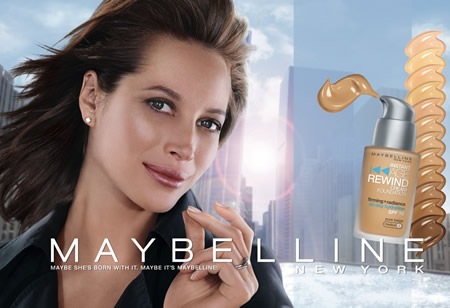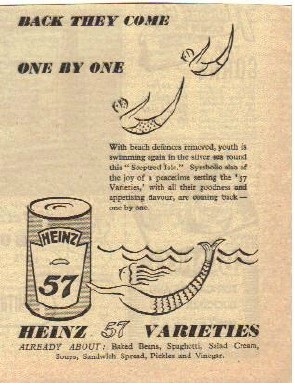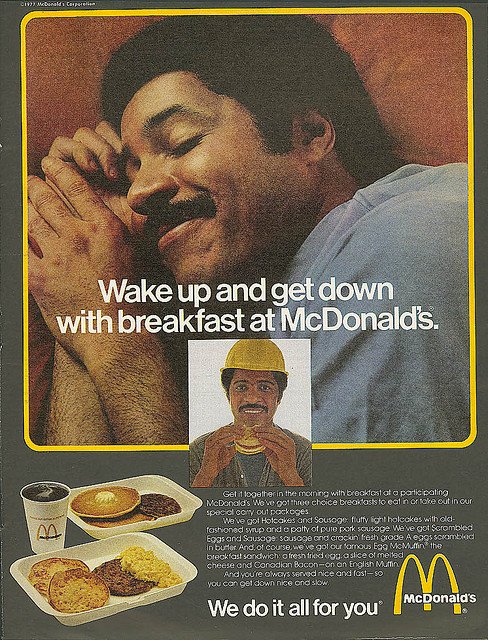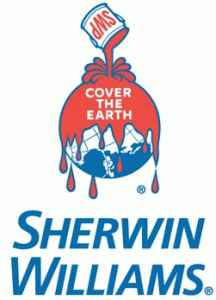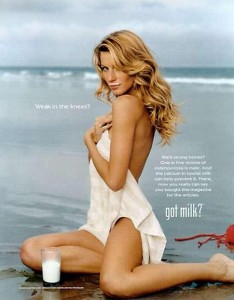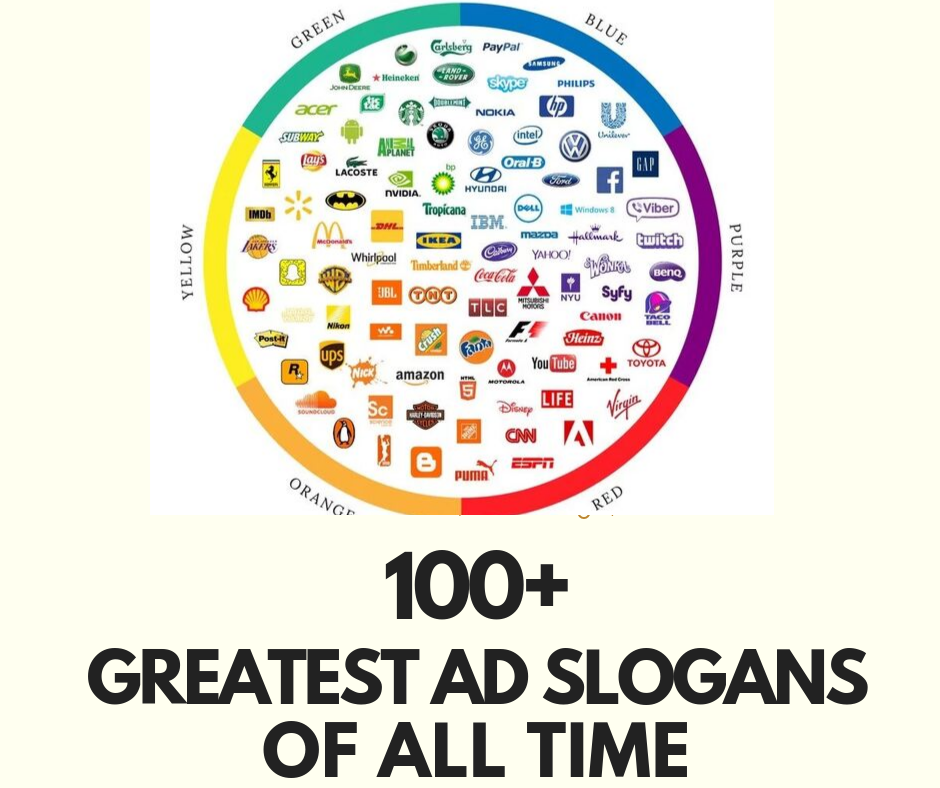
The best advertising slogans are memorable and fit with the times. A good slogan is brief, yet memorable.
Many ad slogans have in fact been around for centuries – or at least decades before marketers decided to associate their brands with them.
For most Americans, when something is described as “Finger lickin'” and “good,” there’s little question that it’s chicken from KFC. Slogans like “Good to the last drop.” “Breakfast of champions,” like diamonds, last forever. Brands pay fortunes to make sure their slogans endure and the brands are recognized by consumers. But only very slogans last forever and become part of everyday conversation.
Similarly for Britons, as per a study, “Good things come to those who wait” becomes the most commonly used ad slogan in their everyday life. Second to the poll is, “Every little helps” from Tesco. Ronseal’s “It does exactly what it says on the tin,” came third. The general feeling in the office that carries the survey is that all the top, enduring slogans are short, catchy phrases which not only identify products but are so memorable they have become part of everyday language.
But then, it’s not easy to define a great slogan. Disney’s “The happiest place on earth” and Nike’s “Just do it” are two of the most recognisable slogans in the world but we can’t really compare them or measure meaningful similarities. Not just they differ in length but they are also contrasting in meaning and complexity.
There are slogans, and then there are taglines. Slogans sum up what a company stands for, whereas a tagline concludes an ad, usually a commercial, with a quick sign off.
Think about the brands that you know well, and perhaps even love. Chances are, it’s not just a brand name you’re recalling, but a tagline, too. Almost all brands, products, and large corporations have some kind of slogan/tagline/punchline, whatever we choose to call it. Some are timeless, others get replaced every decade, quarters or even sooner if it’s stop resonating with the target group.
Some of the most memorable slogans of all time – “Where’s the beef?” or “Just do it” – not only sell the brand, but became synonymous with it
When you hear the phrase, “Just do it,” the first thing that comes mind is probably, Nike. What about “Open happiness,” “The pause that refreshes,” or “It’s the real thing”? Those phrases belong to Coca-Cola.
That’s the power of a good slogan. They’re designed to stay with you seemingly endless repetition through commercials and billboards don’t hurt either).
There are slogans, and then there are taglines. According to brand consultant Laura Ries at Advertising Age, “Taglines are like the road sweepers at the end of a parade … they seldom position the brand.” A slogan, when done right, “sums up a company’s strategy,” she adds.
The top 100 advertising slogans of all time
Adglitz explores 100+ most memorable advertising slogans and taglines of all time.
1. DeBeers: Diamonds are forever – 1948
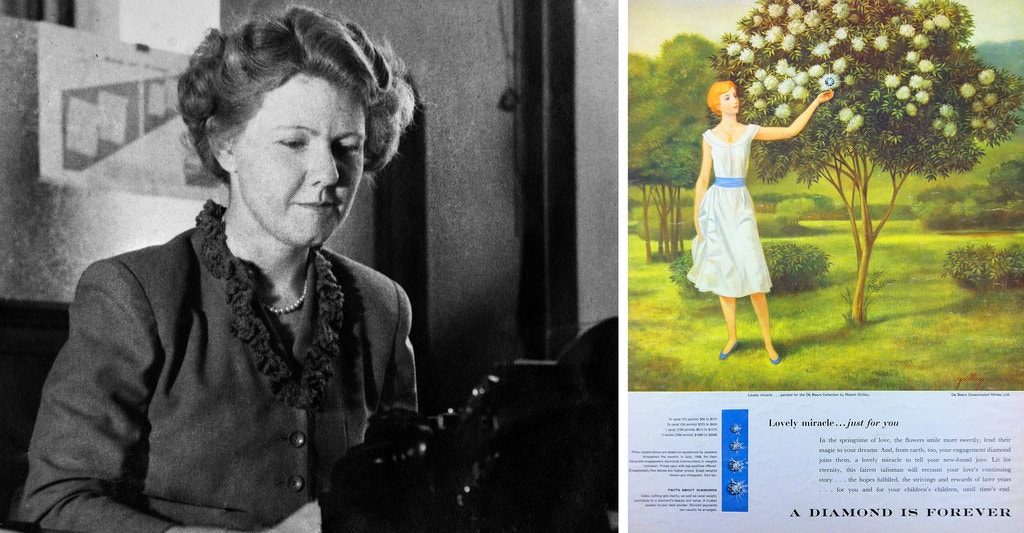

Not many Americans proposed with the diamond engagement ring in the 1930s. For a long time diamond was viewed as symbols of wealth, power and decadent romantic dreams—a stone too precious and expensive to attain, writes AAAA. Then an ad campaign changed everything. Jewelry retailer De Beers hired N.W. Ayer & Son, an advertising agency based out of Philadelphia. Frances Gerety, the female copywriter who never married (pic above) came up with greatest professional achievement in the form of “A Diamond is Forever” which arguably has helped to create a sense of emotional attachment to the diamond engagement ring. And created a multibillion-dollar industry out of it. Since then, from 1947 through 1970, Ms. Gerety dedicated herself to De Beers. The tagline forever changed public attitudes, made diamond precious gemstone of choice for engagement virtually worldwide. The slogan became a symbol of enduring love weaving itself into popular culture and inspiring books, films, and songs. In 1999, Advertising Age proclaimed it the slogan of the century.
2. Nike: Just do it, 1976
The surprising and morbid origin story of Nike’s slogan started with a murder. In 1976, Gary Gilmore murdered a gas-station employee. His lawyers tried to appeal the sentence, but something unusual happened: Gilmore insisted on execution. Before his execution, Gilmore reportedly was asked for any last words. His reply: “Let’s do it,” took much of media space and inspired advertising executive Dan Weiden who coined the term, Just Do It. Full story here.
3. Volkswagen: Think Small, 1959
It is believed that Volkswagen has changed the course of advertising with the ‘Think Small’ campaign. With its perfect blend of wit, humor and appreciation for the intelligence of the customer, it won Americans over in the 50’s and 60’s. Beautifully simple, surprising, minimalistic and relevant even today.
Who would have thought a funny looking car that was named after a bug (beetle), known for not being the fastest and manufactured in factories built by the enemy state would become apple of American eyes?
During 50s and 60s, post WWII, when cars were giants, testosterone boosters and fashion statements, folks at Volkswagen disrupted the traditional narrative with an honest appeal.
With their legendary “Think Small” campaign, DDB did the exact opposite of what every other car ad was doing: They were brutally, boldly and cleverly honest. The truth was that the Volkswagen Beetle was a small, slow and ugly foreign car. By admitting that, and explaining why those were good things, DDB turned the VW Bug into an iconic piece of American pride. Source
An ad heritage that inspires goodwill even today. Yes, the ad is relevant even today. Not just in popular culture or our collective conscience but on more functional fronts too. Volkswagen advertising still uses a similar layout to those first created by the reluctant art director, Helmut Krone. The original agency, DDB still manages the Volkswagen account.
4. Coca Cola: The pause that refreshes, 1929
Coca-cola has many slogans over the last century. Check it up here. This partcular marketing strapline is my favorite as it seems relevant even today. It talks about taking time to pause and refresh brains.
4. Miller Lite: Tastes great, less filling, 1974
Subsidiary of cigarette maker Phillip Morris, Miller Brewing Company launched a new reduced-calorie beer product with the slogan “Tastes Great. Less Filling.” A new category was born. The product introduction later proved to be one of the most significant turning points for the beer industry. Full story here.
5. Avis: We try harder, 1962
Undoubedtly, the most famous and talked about underdog advertising in the history of marketing. Timeless and resonates with people long after it’s been released into the world in 1962. More.
6. Maxwell House: Good to the last drop, 1917
The story has it that Theodore “Teddy” Roosevelt has coined the term while having coffee at at the Hermitage, a famous Nashville resort.
7. Dollar Shave Club: Shave Time. Shave Money
In dealing with its mighty competitor, Gillette, Dollar Shave Club (DSC), a new small startup, goes bold and edgy with its marketing campaign. Being creative and fun “Shave time, shave money” helped DSC connect with its male customers.
8. M&M: Melts in Your Mouth, Not in Your Hands
A study of the antecedents of slogan liking by Texas Tech University found this slogan to be the most liked of all time. M&M trademarked the slogan in 1954 after attaining success with the military and the public in general during the 1940s.
9. Wheaties: Breakfast of champions, 1930s
The iconic orange box and the timeless slogan “Wheaties – The Breakfast of
Champions” has made Wheaties a genuine American icon and a metaphor for greatness and success. Know more
10. Clairol: Does she … or doesn’t she?, 1956
Dyeing and coloring hair was mired withs social stigma back in 1956. Mostly women from stage or sidewalk colored their locks. To eliminiate the social stigma through communication, Clairol hired FCB. Shirley Polykoff, FCB’s sole female copywriter then realized that the proposition to sell Miss Clairol would revolve around reassuring its buyers that the color they’d get from that little box would be so natural, nobody would ever guess. The tagline, “Does she…or doesn’t she?” reaffirmed that belief and the rest was history.
11. Meow Mix: Tastes So Good, Cats Ask for It By Name – 1974
Probably one of the most readily sung ad jingles of its time, the Meow Mix slogan is a kind of heritage or cult that the brand has leveraged for decades. Three generations of consumers have grown up with the jingle and consider it close to their hearts. In the early ‘70s, the original Meow Mix spot was first aired, and since then, remained in consumers’ hearts forever.
12. Morton Salt: When it rains it pours – 1912
The premise was to show Morton Salt was so free flowing that it pours even during rainy weather. The message and the campaign, originated around 1900s, is still considered to be one of the most successful and lasting ideas to originate.
13. Wendy’s: Where’s the beef? – 1984
“Where’s the beef?” instantly captured audience’s attention after the actress named Clara Peller demanded to know this in the commercial.
14. Molson Canadian Beer: I am Canadian, 1994-1998, 2000-2005
With a punch of patriotism this classic beer campaign has tapped into powerful emotions of Canadians and consistently won brand love for over decades.
15. Miller Beer: The Champagne of bottled beer, 1950s

The assertion of the premise, “The Champagne of Bottled Beer,” relied on its dare, bold argument. Luxury in mind, the company designed beer bottled with sloping slides resembling conteporary champagne bottle. Though, a great success of its time Miller later changed strategy and celebrated the working man instead of branding its beer a luxurious item.
16. Dove: Real Beauty Skeches – 2013
Dove’s “Real Beauty Sketches” campaign was a powerful and emotional ad campaign that highlighted the unrealistic beauty standards that women are subjected to in the media. The slogan sparked a conversation about body image and self-esteem.
17. Verizon: Can You Hear Me Now? Good – 2002
From 2002 to 2011, a simple question dominated the airwaves: “Can you hear me now?” This iconic phrase, uttered in a series of Verizon commercials, became the brand’s catchphrase for nearly a decade. Unlike competitors who focused on price, Verizon’s clever marketing strategy took a different approach, highlighting the reliability and signal strength of their network. The campaign’s success cemented the importance of clear calling in the age of mobile phones.
18. T-Mobile: Stick Together, 2006
To offer its new calling plan of unlimited calling to select five members, T-Mobile unveiled Stick Together tagline. The campaign was preceded by Get More in 2005 and followed by Uncarrier in 2013.
19. FOX News: Fair and Balanced, 1996
Co-founder Roger Ailes conceptualized the iconic catchphrase during the formation of the network. After his demise at the age of 77, Fox News has dropped it for a new slogan, Most Watched. Most Trusted.
20. WINS Radio: You give us 22 minutes, we’ll give you the world, 1965
WINS, 1010 on the AM dial initiated this easily identifiable and distinctive slogan to promote its twenty four hours programming. The tagline is a reference to WINS’s format clock, which returns to the top stories every twenty minutes. WINS also has used other memorable slogans such as All news, all the time, The newswatch never stops, Listen two, three, four times a day.
21. The U.S. Marine Corps: Semper Fi – 1883
Latin for “always faithful,” Semper Fidelis has been the Marine Corps motto since 1883. It embodies the Corps’ value of honor, courage and commitment. Read more from official United States Marine Corps website
22. HBO: It’s not TV, it’s HBO – 1997-2009
An iconic slogan, an assertion that has endured long after the slogan was retired. The slogan ‘It’s Not TV. It’s HBO’ was introduced in 1996 as a smart way of differentiating a HBO series from its competition by distinguishing its original series as something unique and of value – something audiences cannot get elsewhere. The spots, conceived by ad agency BBDO New York, sought to reflect the spirit and the programming of HBO. Instead of previewing upcoming events or providing a traditional ‘‘tune-in’’ message, the ‘‘It’s Not T.V. It’s HBO’’ campaign attempted to present the viewer with a sample of HBO’s programming. Link
23. Ronseal: It Does Exactly What It Says on the Tin – 1994
In 1994 the owner of the company Ronseal wanted a catchphrase that, without trying too hard, would demystify the products while wearing puns of art instead of calling a spade a spade.
Such is the power of the Ronseal slogan that people now use it in their everyday lives. So when someone says, ‘Does Exactly What it Says on the Tin,’ it represents a genuine and honest product or policy. New folks are surprised to know that the slogan is not part of everyday language vernacular but derived from an advertising campaign.
‘Does exactly what it says on the tin’ is now part of the Oxford Dictionary of Idioms.
24. Marlboro: The Marlboro Man, 1955
The most powerful — and in some quarters, most hated — brand image of the century, the Marlboro Man stands worldwide as the ultimate American cowboy and masculine trademark, helping establish Marlboro as the best-selling cigarette in the world, writes AdAge.
25. The Mosaic Company: We Help the World Grow the Food It Needs
The Mosaic Company’s slogan is not just meant for one campaign or product category. It’s more than that. In fact, ‘Helping the World Grow the Food It Needs’ is the organization’s mission statement. As a sustainable farming company, it has a noble mission and deeply ingrained values.
26. McDonald’s: You deserve a break today, 1971
By all accounts, McDonald’s best-remembered powerline in over sixty years of selling burgers, shakes, and fries, is “You Deserve a Break Today,” created by advertising agency Needham, Harper & Steers in 1971. It was put to music as part of a jingle that became the centerpiece of a multimillion-dollar television and print campaign, observes Steve Cone in his book “Powerlines: Words That Sell Brands, Grip Fans, and Sometimes Change History”
Keith Reinhard, one of the frontmen behind the campaign reminisces the premise here. He writes,
But we had gathered research confirming that consumers in those days needed an escape from the humdrum and sameness of their lives. Moms needed an escape from meal planning, dads needed relief from the high price of eating out, kids needed a respite from broccoli and table manners, and on and on. Folks needed a getaway from their daily routines.
27. Absolut Vodka: The Absolut Bottle, 1981
Since its inception in 1981, there was probably not a single popular magazine or direct mail magazine left from any niche where Absolut Vodka hadn’t adorned its page. Considered as the longest running print ad marketing campaign in history, the ads themselves have become collector’s items, unparalleled since those created for Volkswagen in the 1960s.
28. Subway: Eat Fresh
Simple and straight, Subway’s ‘Eat Fresh’ indicates the usage of fresh ingredients in the subs and sandwiches. Back in 1965, when consumers were not as health freaks as they were today, when gimmicks and artificial ingredients ruled fast food businesses, the idea of freshly made healthy sandwiches seemed crazy.
Today, Subway is the world’s largest quick-service restaurant brand, and 56 years later, it still holds its old slogan.
29. Federal Express: Fast Talker, 1982
Such was the impact of this TV commercial that it brought activity to a halt in households every time it aired. Considered as one of the greatest comedy spots of all time, Federal Express’s Fast Talker won plenty of advertising awards including six Clio Awards. John Moschitta who unleashed his manic mouth became a household name overnight. The campaign which was also about mobility or things in motion is relevant even today.
30. BMW: Designed for Driving Pleasure
“Sheer driving pleasure” has been a BMW slogan for over half a century. And, after so many decades, today, it seems even more relevant than ever. According to Jochim Blickhäusr, the head of corporate and brand Identity at the BMW Group, the tagline delivers positive emotions and does exactly what a claim should.
Though technically the slogan originated in 1965, the first use of ‘pleasure’ appeared in BMW advertisements in the 1930s. In 1936, a billboard for BMW cars and motorcycles informed drivers, “Kraftfahren muss Freude bereiten!” (driving should be a pleasure!).
31. Pepsi-Cola: Pepsi-Cola hits the spot, 1939-1949
The 1930s saw a boom in radio ownership as the number of American homes with a set soared from 40 percent at the start of the decade to nearly 90 percent at its end. CocaCola got into radio advertising early, running its first radio spots in 1927, but struggled to find a way to translate Lee’s effective print promotions to the new medium. Even after more than a decade on the air the company was still scratching its head about how to sell itself over the airwaves, with Coke executive Ralph Hayes lamenting in 1938, “For whatever reasons, our several radio experiments, up to now, have been less than satisfactory or successful. To date, it has probably been our least effective medium, considering the expenditures involved.”
The following year Pepsi showed them how to do it with a campaign that not only sold its drink but altered the way radio advertising was done. The campaign started when two songwriters, Alan Kent and Austen Croom-Johnson, wrote a song for the company called “Pepsi-Cola Hits the Spot,” based on the tune of “Do Ye Ken John Peel.”
Pepsi decided the song should run on the radio by itself. But the advertising agency was horrified. At the time radio advertisements were long, rambling affairs that, like a second-rate politician’s speech, tended to drone on and on. Even the shortest lasted at least five minutes. So when Pepsi asked radio stations for a thirty-second slot to play their record, the big stations refused to run such a short ad.
Eventually the company got the song aired on a number of small cashstrapped stations, and it became an instant hit with listeners. Soon big stations were clamoring for the chance to play it too.
A vinyl recording of the tune sold more than one hundred thousand copies and in 1941 alone it was played on the radio more than three hundred thousand times, often without Pepsi paying a cent. Ten years after its 1939 debut, “Pepsi-Cola Hits the Spot” was still being played on air, and other radio advertisers had followed Pepsi’s lead and started running shorter, snappier ads. “When I listen to some of the jingles that come pouring forth, I’m not so sure that I started such a good thing,” Mack reflected years later in his 1982 biography.
Off the air, Pepsi’s promotional work was scrappier, reflecting its status as an upstart with everything to gain and little to lose. Excerpts from Fizz How Soda Shook Up the World by Tristan Donovan
Take a listen
32. Ivory Soap: 99 and 44/100% Pure, 1882
Proctor & Gamble (P&G) first used this slogan in 1895 after a market survey. It wanted to emphasise that Ivory Soap was purer than the average castile soap.
33. Tesco: Every Little Helps
Classical and seemed like a proverb, ‘Every Little Helps’ is the kind of thing that a grandfather would say, a saying that seemed seeped in vernacular wisdom. It’s not just conversational, but it’s so easy that it’s impossible to miscomprehend also.
For Tesco, it is much more than an advertising endline; it goes beyond just helping customers with shopping, acting as a guiding light to the retail major since 1993.
34. American Express: Do you know me? 1975
American Express’s “Do you know me?” campaign officially ran for over a decade. It carried the corporate template of stressing prestige and inviting eligible consumers to join the exclusive club membership. It used a variety of celebrities receiving special treatment and recognition that card members enjoy around the world with a tagline “Don’t leave home without it.” A successful campaign, it produced 120+ commercials.
35. Bounty: The Quicker Picker Upper
Bounty inherited the slogan from Charmin in 1957 when Procter & Gamble (P&G), its parent company, acquired it. Bounty replaced Charmin products in 1965, but the ad campaign consisted of the slogan until the 1990s.
36. US Army: Be all that you can be, 1980
US Army coined the slogan, “Be all that you can be” in 1980 and continued to run it till 2001 and used it for recruitment for over twenty years. In January 2003, US Army awarded the copywriter, Earl Carter, with Outstanding Civilian Service Award.
37. Audi: Advancement Through Technology
In 1971, Audi introduced the tagline “Advancement Through Technology” or “Vorsprung durch Technik.” For all these years, the phrase became the key message underlining the company’s expertise. Then, Hans Bauer, an Audi NSI advertising department employee, conceptualized the idea of leveraging technological diversity and advancement as an expression of the company’s future-oriented approach.
38. Nickelodeon TV Channel: Nick is for kids, 2004
A popular hangout for kids aged between six to 12, Nickelodeon has built a diverse, global business by putting kids first in everything it does. The tagline ‘Nick is for kids’ is a testimony to this.
39. Best Buy: Thousands of possibilities. Get yours
For a company like Best Buy, a consumer electronics retailer that allows customers to discover, try and buy a wide range of products from every category, this slogan seems functional to its very base.
Per its admission, Best Buy interacts with its customers 3 billion times a year. So, the slogan might not sound too clever or catchy, but it caters to its target audience while offering its core proposition.
40. Dunkin’ Donuts: America Runs on Dunkin
With the ‘America Runs on Dunkin’ campaign Dunkin’ Donuts mounted an ambitious nationwide campaign. The slogan tries to connect American people with American values of hard work and fun. The multi-million dollar campaign transformed Dunkin’ Donuts’ position by focusing on how the brand keeps busy Americans charged up and on the go.
41. Toshiba: Hello Tosh, gotta Toshiba? – 1984
A cult campaign which had a voiceover by the late singer Ian Dury with words adapted from the lyrics of Alexei Sayle’s novelty single, Ullo John! Gotta New Motor?.
42. The New York Times: All the News That’s Fit to Print – 1897
In 1897, Adolph S. Ochs, the owner of The New York Times, created the famous slogan “All the News That’s Fit to Print,” which still appears on the masthead of the newspaper today. He wrote the slogan as a declaration of the newspaper’s intention to report the news impartially.
43. Energizer Batteries: Keeps going and going and going – 1991
A subtle and sustaining aspect of the campaign has been its evolving tagline, “Keep going and going …” For every appearance of the Energizer Bunny, the truer the line becomes. A decade after the campaign was born, Ad Age named the Energizer Bunny one of the top brand icons of the century.
44. General Electric: Imagination at Work – 2003
In 2003, General Electric (GE) aimed to revitalize its brand image with a new slogan: “Imagination at Work.” This replaced their previous tagline, “We Bring Good Things to Life.”
45. Intel: Intel inside – 1990s
Considered one of the most successful taglines in the technology industry “Intel Inside” helped the company become a household name across the world.
46. Apple Computer: Think different – 1990s
Apple’s catchy phrase “Think Different” became super famous and is still remembered today. It completely changed how people saw advertising and even computers themselves! It wasn’t just about selling computers anymore; it was about a whole new way of thinking.
47. Microsoft: Where do you want to go today? – 1994
That was Microsoft’s first worldwide advertising campaign. It involves print, television, outdoor (billboard) medium. Launched in 1994, the campaign costs Microsoft $100 million till the end of 1995, out of which $25 million was spent during the holiday shopping season ending in December 1994.
48. State Farm: Like a Good Neighbor, State Farm is There
The slogan means that State Farm wants to be more than just an insurance company. They want to be like a friend its customers can count on, someone who will be there for them when things go wrong, just like a good neighbor would. This motto shows how much they care about their customers and want to build a long-lasting relationship with them.
49. AOL: Welcome to the World Wide Wow – 2002-2003
Not a favorable review of the campaign. Consider this take from a 2003 report from the Washington Post
the future of the United States’ No. 1 Internet provider depends on its ability to persuade its 35 million subscribers to upgrade to AOL Broadband, which combines enhanced AOL content with costlier high-speed Internet access.
50. SBC-Yahoo: It’s the Internet that logs onto you – 1996
51. Free Software Foundation: GNU is Not Unix – 1983
The GNU Manifesto begins by outlining the goal of the project GNU, which stands for GNU’s Not Unix. The current contents of GNU at the time of writing are then described and detailed. Richard Stallman then goes into an explanation of why it is important that they complete this project. The reason he explains is based on Unix becoming a proprietary software…A large part of the GNU Manifesto is also focused on rebutting possible objections to GNU‘s goals. Objections described here include the programmer’s need to make a living, the issue of advertising/distributing free software, and the perceived need for monetary incentive. Source: Wikipedia
There are various forms of free or very cheap publicity that can be used to inform numbers of computer users about something like GNU. But it may be true that one can reach more microcomputer users with advertising. If this is really so, a business which advertises the service of copying and mailing GNU for a fee ought to be successful enough to pay for its advertising and more. This way, only the users who benefit from the advertising pay for it. Source: The GNU Manifesto
52. Edison Records: Echo Around the World – 1906

53. State Farm: Like a Good Neighbor, State Farm is There – 1971
“The simple tagline, “Like a Good Neighbor, State Farm is There” reflects how State Farm agents and employees make a meaningful difference helping others. As a trustworthy insurance company, State Firm wants to be like a friend its customers can count on, someone who will be there for them when things go wrong, just like a good neighbor would.
54. Heinz: Even when it isn’t Heinz, it has to be Heinz – 2023
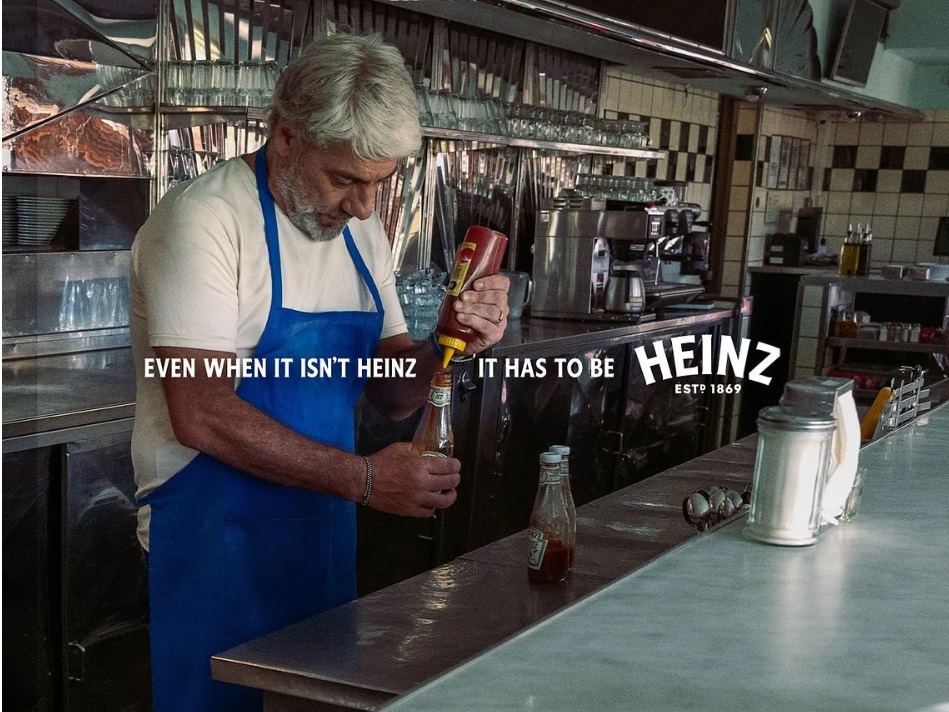
Heinz’s first global campaign in its 150-year history asserted the brand’s status by featuring photos of restaurant workers caught refilling Heinz bottles with a cheaper substitute.
55. The U.S. Marine Corps: The Few. The Proud. The Marines
Marine Corps has been consistently using this recruitment slogan since 1977. It’s not merely a tagline for the military. The campaign won Madison Avenue’s Advertising Walk of Fame during Advertising Week 2007. This historic slogan has become a part of the Marine Corps’ lexicon.
56. Old Spice: Smell like a man, man!
According to CBS News, Old Spice’s “Smell like a man, man” was the most talked about ad of 2010, a cultural sensation, and the most popular interactive campaign in history. Advertising Age called it one of the top campaigns of the 21st century.
57. Allstate Insurance: You’re in good hands with Allstate – 1956
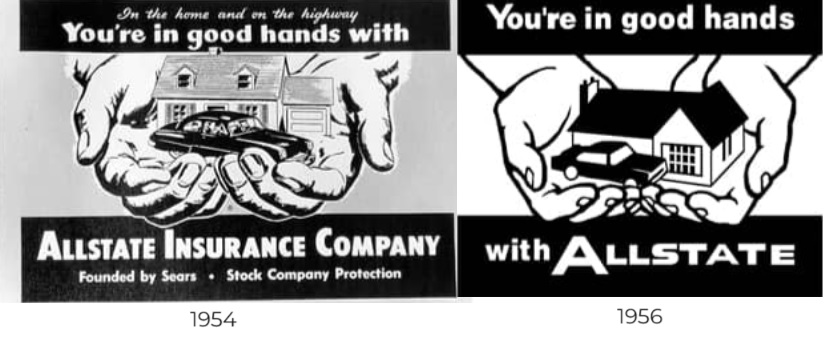
Allstate sales director Davis Ellis was at a meeting with advertising agency to plan company’s ad programs. During the meeting, Ellis remembered a time when his daughter was sick. He was worried, but then someone said, “She’s in good hands,” and he felt better.
Ellis thought this would be a great message for Allstate’s ads. He suggested using the words “In good hands” along with a picture of hands holding a car carefully. Everyone at the meeting loved his ideas, and that’s how the famous “Good Hands” symbol was born!
58. Netflix: See what’s next – 2018
“See What’s Next” is a succinct tagline that encapsulates Netflix’s mission and disposition, a nod to the numerous titles that are instantly available to watch at the click of a remote. The tagline also speaks to Netflix’s maverick, pioneering spirit. Connecting people to stories is Netflix’s core objective, and anticipation is at the very heart of storytelling.
59. FedEx: When it absolutely, positively has to be there overnight – 1978
FedEx’s iconic slogan, “When it absolutely, positively has to be there overnight,” isn’t just catchy or superficial. it’s a guaranteed promise and ingrained in its service. This powerful phrase emphasizes the company’s core strengths: reliability and speed. In just a few words, it assures customers that FedEx can get their packages where they need to be, fast. FedEx used the slogan from 1978-1983.
60. Bell AT&T: Reach out and touch someone – 1979
Imagine 1979. Long-distance calls were a hassle – from unreliable connections to unclear voices. Back then, making a long-distance call was stressful. That’s why, in 1979, AT&T launched a campaign promising a new experience through its phone service: “simple, non-traumatic” long-distance calling.
61. Van Dyke Records: Each Record a Masterpiece – 1929
62. King Records: If it’s a King, It’s a Hillbilly — If it’s a Hillbilly, it’s a King – 1930s

Founded in 1943, King Records capitalized on the popularity of “hillbilly” music with their catchy rhyme and name association, “If it’s a King, it’s a hillbilly.
In the 1940s, “hillbilly” music was a popular genre among white audiences in the US, particularly in rural areas. The slogan served to clearly identify King Records’ focus on this specific style.
Not famous today, Hillbilly is now considered a derogatory term meant for rural people. The slogan also lost relevance as King Records diversified into R&B.
63. Timex: It takes a licking and keeps on ticking – 950s
Sounding little bit creepy? Well, back in 1950s we probably were not as complicated as we are today. The new Timex tagline is “Timex. Life is ticking”
THE venerable theme for Timex, ”It takes a licking and keeps on ticking,” looks to be taking a final licking.
The Timex Corporation, in a campaign from its new agency, Kirshenbaum Bond & Partners in New York, is dropping the ”licking/ticking” slogan — introduced in the 1950’s and brought back in the 1990’s — for a theme intended to help update its image. The goal is to freshen the Timex appeal with consumers ages 18 to 34, whose wrists are increasingly sporting other watch brands like Kenneth Cole, ESQ, Marc Ecko, Fossil, Guess, Swatch and Swiss Army that they deem more hip.
The theme change, to ”Timex. Life is ticking,” is part of an advertising makeover after Timex left its agency of 16 years, Fallon Worldwide in Minneapolis, part of the Publicis Groupe. Source: The New York Times
64. Playtex: Lifts and separates – 1954
Now a well-known phrase, part of everyday conversation and well-referenced in popular culture, “lifts and separates” is a slogan that Playtex used in its advertising campaign to support its launch event in 1955. In fact, Playtex was the first brand to dare to mention lingerie on TV.
65. Kentucky Fried Chicken: Finger-lickin’ good!, 1952
KFC’s “Finger-lickin’ good” is probably one of the most well-known slogans of the 20th century.
As the story goes, a KFC commercial featured an actor in the background enjoying chicken by licking their fingers. A viewer complained, and the ad manager famously said, “Well, because it’s finger lickin’ good!” This spontaneous remark later became KFC’s iconic slogan.
66. Maybelline: Maybe she’s born with it – maybe it’s Maybelline – 1991
Launched in 1991, this slogan has won the world over. Its brilliance lies in the fact that it suggests Maybelline supplies makeup that doesn’t just make women appear beautiful, but naturally beautiful. Onlookers won’t be able to tell if someone’s beauty is natural or enhanced, an insightful piece of marketing for the beauty market. A testament to its aptness, the slogan is still going strong today.

Victoria’s Secret Angel Adriana Lima has been Maybelline spokesperson from 2003 to 2009.
Former Elite magazine model Josie Maran became the brand ambassador of Maybelline in 1999, and later formed her own skincare line, Josie Maran Cosmetics.
67. Mastercard: There are some things money can’t buy. For everything else, there’s MasterCard – 1997
For over 30 years, Mastercard’s “Priceless” campaign has captivated audiences with its simple yet powerful tagline. This enduring message has resonated for more than two and a half decades, capturing the imagination of billions across the 210 countries where Mastercard processes transactions.
“Priceless” has transcended language and cultural barriers, becoming synonymous with Mastercard and the creation of unforgettable memories and experiences. This resonates even more today, as people reconnect and rediscover their passions.
68. VISA credit card: VISA – It’s everywhere you want to be – 1985
Back in 1985, Visa noticed something strange – they didn’t stand out as much as Amex or Mastercard in the consumers’ mind. But Visa had a secret weapon: more Americans used their cards, and more stores accepted them than any other credit card. To fix their image, Visa teamed up with a famous ad company called BBDO. Visa and BBDO had two big goals for their new campaign: 1) Make Visa seem different from Mastercard, who was becoming a big competitor, and 2) Remind everyone that Visa was the most accepted credit card in the world, fancy and convenient all at once.
The results were phenomenal! A Visa spokesperson, quoted in American Banker on September 23rd, 1993, said the ad campaign “succeeded beyond anyone’s wildest imagination.” Visa’s sales doubled during the campaign’s run, and their share of the credit card market jumped from 43.8% in 1985 to a whopping 52%.
69. Merrill-Lynch: Merrill-Lynch is Bullish on America – 1970-71
[Please keep in mind, this video also includes other ad spots as well with Bullish on America (between @6.01 to @6.550. They are Fantastik cleaner by Texize, FDS new improved feminine hygiene spray, GAF sheet vinyl floor with Henry Fonda, GTE/Sylvannia color television, Hormel Hot Chili (done cowboy style)]
70. Midland Bank: The Listening Bank – 1990s
Midland Bank’s slogan, “The Listening Bank,” was more than just catchy. It showed importance of customer centricity! Back then, banks didn’t focus much on listening to their customers.
But Midland Bank’s vision showed how important listening to customer really is and that greater customer centricity could also be a selling proposition. Today, banks everywhere try their best to understand what their customers need. With all the new technology like data, analytics and AI, banks listen to their customers even better and push for improved customer service. This way, they can create financial plans that fit each customer’s needs and keep their customers happy. The “listening bank” concept, today seems remarkably ahead of its time.
71. 7-Up: The uncola – 1973
In 1967, 7Up faced a challenge: sales were low, and the drink was seen as a mixer or a medicinal remedy. They aimed to rebrand it as a mainstream soft drink, competing with established giants like Coca-Cola and Pepsi. J. Walter Thompson, the ad agency they partnered with, saw an opportunity in the turbulent social climate of the late 1960s. The Vietnam War and the Civil Rights Movement fostered a rebellious spirit, and JWT capitalized on this by creating the “Uncola” campaign.
“Uncola” was a stroke of genius. It positioned 7Up as the antithesis of the established cola brands. The 1968 ads used playful puns based on “un” and cleverly portrayed Coke and Pepsi as the “establishment,” resonating with a generation yearning for alternatives. 7Up became the cool, unconventional choice, perfectly capturing the counterculture spirit.
72. Abbey National: Because life’s complicated enough – 2003
In the early 2000s, things were getting crowded in the UK banking world. Abbey National (defunced in 2010), a big bank back then, wanted to stand out from Barclays and Lloyds TSB. Their goal: create a saying that would really connect with their customers on an emotional level.
And connect it did! “Because life is complicated enough” became their main marketing message. This simple slogan was a hit. It spoke to everyday people who were stressed about managing their money, making Abbey National seem like a bank that truly understood their struggles.
Even though Abbey National itself is gone now (they were bought by Santander in 2008), their slogan is still remembered as a great example of marketing that works. It shows the power of caring about your customers and using clear language to build trust and brand loyalty.
73. E.F. Hutton: When E. F. Hutton Talks, People Listen – 1970s, 1980s
E.F. Hutton, an American stock brokerage firm founded in 1904, wanted to portray itself as a knowledgeable and trustworthy source of financial advice in the late 1970s and early 1980s. To achieve this, they launched a new campaign featuring the now-iconic slogan.
Initially they wanted to rope in a few celebrities but decided against it after testing revealed regular people were more believable and relatable.
The campaign was a massive success. The catchy slogan, combined with the intriguing visuals, created a sense of mystery and authority around E.F. Hutton. People perceived them as a firm with valuable investment insights worth listening to.
The campaign’s influence extended beyond finance. The slogan became a popular catchphrase used in various contexts, demonstrating its memorability and cultural impact.
74. Trustee Savings Bank (TSB): The bank that likes to say Yes – 1980s
In 1984, TSB adopted an advertising slogan by which it is still generally remembered today: “The Bank That Likes To Say Yes.” The slogan conveyed an attitude of approachability and willingness to help customers, potentially with loans or other financial services. The story has it that the “Yes” in the slogan wasn’t always the chosen word. During the campaign development stage, the team tested various options like “help” and “understand.” However, “Yes” ultimately resonated best with target audiences due to its positive and direct connotation.
75. Washington Mutual: More human interest – 2003
Washington Mutual (WaMu), America’s largest savings and loan association wanted to move away from the traditional, sterile image of financial institutions and create a more relatable and approachable brand in the wake of new millennial. Broadly it catered to lower- and middle-income customers that other banks considered too risky.
The campaign successfully positioned WaMu as a bank that cared about its customers and their aspirations. The human-interest approach fostered stronger customer relationships and loyalty. The bank closed its doors in 2008 due to a confluence of factors related to the subprime mortgage crisis.
76. Trebor Mints: A minty bit stronger – 1969
Trebor Mints first burst onto the scene in 1964 with a slogan that perfectly captured their essence: “Trebor Mints are a minty bit stronger.” This iconic phrase resonated so deeply with consumers that it was brought back for Trebor’s 100th anniversary in 2014, solidifying its status as a classic in the advertising world.
77. Yellow Pages: Let your fingers do the walking – 1964
Before the “Let Your Fingers Do the Walking” campaign, telephone directories were simply informational resources, lacking a strong brand identity. The campaign proved to be a resounding success. The slogan became a cultural touchstone, firmly associating Yellow Pages with finding local businesses. Even in the age of online directories, “Let Your Fingers Do the Walking” remains a memorable and effective example of advertising.
78. Heinz Baked beans: Beanz Meanz Heinz – 1967
Advertising executive Maurice Drake crafted the now-iconic phrase “Beanz Meanz Heinz,” which has become one of the most recognizable advertising slogans in the United Kingdom. Even over six decades later, the seemingly timeless slogan retains its relevance and brand power, continuing to resonate with different generations in an ever-evolving world.
79. Lay’s potato chips: Betcha can’t eat just one – 1960
Lay’s hit the jackpot with their famous slogan, “Betcha can’t eat just one!” They made it super popular with funny commercials on TV and in magazines. By using celebrities, catchy wordplays, and showing how delicious their chips are, Lay’s became one of the most well-known and loved snack brands in American history!
80. Mars bar: A Mars a day helps you work rest and play – 1980s
Confectionery giant Mars’ famous strapline “A Mars a day helps you work rest and play” was introduced to support its expansion plan amidst increasing competition in the segment like Galaxy and Aztec.
The slogan emphasized that Mars could be enjoyed throughout the day, whether needing a pick-me-up at work, relaxing during a break, or enjoying leisure activities.
Mars stopped using the “Work, Rest, and Play” slogan in 1997 after a long run of 37 years. They wanted to give the candy bar a fresh image. But the idea kind of came back to life many times with different phrasings, like “A Mars a Day Helps You Work, Rest, and Play,” “Mars – The Energy Bar for Work, Rest, and Play,” and “Work. Rest. Play Longer.”
81. Las Vegas: What happens here, stays here – 2002
In 2003, a government agency launched a campaign to makeover the city’s image from being a gambling destination to a place for adult freedom and excitement.
Basis brief and market research, the advertising agency R&R Partners developed the Las Vegas slogan – What happens here, stays here. The campaign was an instant success.
A USA Today survey named the campaign the “most effective” of 2003, while the trade publication Advertising Age termed it “a cultural phenomenon.” The Boston Globe noted, “Campaign phrase enters the lexicon.” The phrase was widely referenced in pop culture, including on Saturday Night Live, Meet the Press, Jeopardy!, Wheel of Fortune, and even the Academy Awards. Two years later, then-First Lady Laura Bush used the tagline in a discussion with Jay Leno on The Tonight Show. The slogan’s influence extended beyond pop culture, becoming the title of the 2008 American comedy “What Happens in Vegas.” It also inspired a song of the same name by Usher, as well as the film series “The Hangover.”
82. Milk tray chocolate: All because the lady loves Milk Tray – 1960s

83. Smarties: Do you eat the red ones last? – 1970s
Back in the 1970s, Smarties, those colorful chocolate candies like M&Ms, came out with a super catchy jingle that had everyone asking, “Do you eat the red ones last?” This question stuck around for 30 years and even pops up sometimes today!
Why was it so successful? Well, it was short, easy to remember, and fit perfectly with the colorful candy. Plus, it got people thinking – do you save the red ones for a special bite, or gobble them all up together? No matter how you eat your Smarties, the jingle made them a candy everyone knew and loved.
84. Ready Brek Porridge: Central heating for kids – 1970s
85. Virginia Slims Cigarettes: You’ve come a long way, baby, 1968
86. H.J. Heinz company: 57 Varieties – 1911
For over a century, Heinz ketchup has been synonymous with the number 57. Their iconic “57 Varieties” slogan, a cornerstone of their early marketing strategy, remains on the bottle to this day. But there’s a surprising truth behind this famous number: it’s completely arbitrary!
Consumers though have come up with all sorts of explanations – from the year the company was founded to the number of tomatoes in a bottle. However, the answer is much simpler. Inspired by a shoe store featuring 21 styles, founder Henry Heinz chose 57 at random, forever linking it to his brand’s identity.
87. McDonalds: Have you had your break to day? – 1997
McDonald’s “We do it all for you”
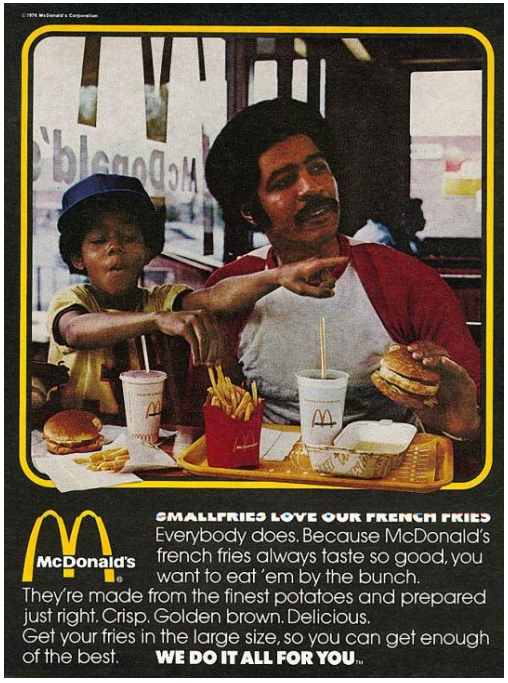
88. Taco Bell: Think outside the bun – 1981
Taco Bell, a fast-food giant known for its Mexican-inspired fare, wanted to shed its traditional image and wear a more modern and innovative avataar
So it onboarded Wieden+Kennedy, a famous ad agency. After extensive brainstorming and research, the agency and management finalize the concept: “Think Outside the Bun.”
The slogan was an instant hit. It perfectly captured Taco Bell’s desire to differentiate itself from traditional burger chains. The catchphrase quickly became a central element of their brand identity and resonated well with customers seeking a fresh and exciting fast-food experience.
89. Domestos: Big Bad Dom – 1987
90. Fairy Liquid “For hands that do dishes…”
91. Flit insecticide “Quick, Henry, the FLIT!” – 1932
Following World War II, concerns about insect-borne diseases like malaria and dengue fever rose dramatically. This made effective insect control a top public health priority. Flit, a popular insecticide brand at the time, wanted a campaign that clearly instructed people on how to react to seeing a flying insect.
Famous children’s author Theodore Geisel, better known by his pen name Dr. Seuss, was brought in to write a slogan. Based on the brief, he came up with the now-iconic “Quick, Henry, the Flit!”
The slogan’s popularity went beyond just advertising. It became “household lingo” in America during World War II, a testament to its effectiveness.
92. Sherwin Williams Paint: Covers The Earth – 1905
Sherwin-Williams paint once boasted a logo with the intriguing tagline, “Covers the Earth.” This slogan, believed to have originated in the 1890s, became an official part of the logo in 1905 and remained there for a significant 70 years before being replaced in 1974.
While some might consider “Covers the Earth” to be an outdated or even boastful phrase, it undeniably served its purpose. Effective advertising isn’t always about aesthetics; it’s about conveying a message that resonates with the target audience. In this case, the slogan’s power lay in its simplicity. It effectively communicated the idea that Sherwin-Williams paint was a versatile product, suitable for all climates and surfaces.
93. Clairol Herbal Essences: A totally organic experience – 1994
Clairol revitalized a tired shampoo brand by understanding the needs of busy 90s consumers. They repositioned it as a moment of indulgence with a soothing scent and a playful campaign featuring the tagline “totally organic experience.” This resonated with the target audience and effectively communicated the brand’s new focus on self-care.
The success went beyond shampoo; Clairol leveraged the momentum to launch a body wash in 1997, expanding their reach into a new category while maintaining the core message. This strategic relaunch exemplifies how a brand can breathe new life into a product by understanding its audience and crafting a compelling message.
94. Remington Shavers: I liked it so much I bought the company – 1979
American entrepreneur Victor Kiam II was a huge fan of Remington’s smooth shave. He liked the Remington electric razor so much that he bought the company and broadcasted to the world through memorable television and radio advertisements. His catchphrase, “I liked it so much, I bought the company”, made him a household name.
95. L’oreal: Because you’re worth it – 1973
Forget waiting for someone else’s approval! L’Oreal’s groundbreaking tagline, “Because You’re Worth It,” was the first ad campaign to focus on a woman’s self-confidence and her own sense of beauty. This empowering message has resonated for decades, uniting women of all ages and backgrounds to believe in their worth
96. Disneyland: The happiest place on Earth – 1960s
Before Disneyland was opened in 1955, Walt Disney and his marketing team needed help to settle for the most appropriate tagline that could clearly convey their fantastical vision for the theme park. After shortlisting 31 crazy slogans, they finally embarked on the now iconic “The Happiest Place On Earth.”
97. Adidas: Impossible is nothing – 2004
Adidas’ “Impossible Is Nothing” campaign, launched in 2004, became iconic by using powerful storytelling to inspire people to dream big and conquer challenges. The enduring slogan resonated globally, redefining sports as a tool for self-discovery and pushing boundaries.
98. BMW: Sheer Driving Pleasure – 1972
For over 50 years, “Sheer Driving Pleasure” has captured the essence of owning a BMW. This iconic slogan transcends mere performance specs, focusing instead on the pure joy and emotional connection drivers experience behind the wheel.
99. California Milk Processor Board: Got milk? – 1993
The now-iconic “Got Milk?” campaign turns 32 this year, its impact on advertising still unmatched. Launched in 1993, the simple question infiltrated American life, reaching an estimated 80% of consumers daily. The campaign’s success went beyond sales, racking up awards and inspiring countless parodies and imitations.
100. American Express – Don’t leave home without it – 1975
In 1975, advertising agency Ogilvy & Mather created the iconic slogan “Don’t leave home without it” to promote American Express Traveler’s Cheques. This catchy phrase became synonymous with the brand’s image and played a crucial role in shaping American Express’s reputation for security and convenience.
101. Covergirl – Easy breezy beautiful
Not a decade or two, CoverGirl ran this slogan for five decades, discontinued it briefly for a couple of years, and then brought it back again in 2019.


